sunroof BMW 6 SERIES GRAN COUPE 2014 F06 Owner's Manual
[x] Cancel search | Manufacturer: BMW, Model Year: 2014, Model line: 6 SERIES GRAN COUPE, Model: BMW 6 SERIES GRAN COUPE 2014 F06Pages: 253, PDF Size: 5.47 MB
Page 21 of 253
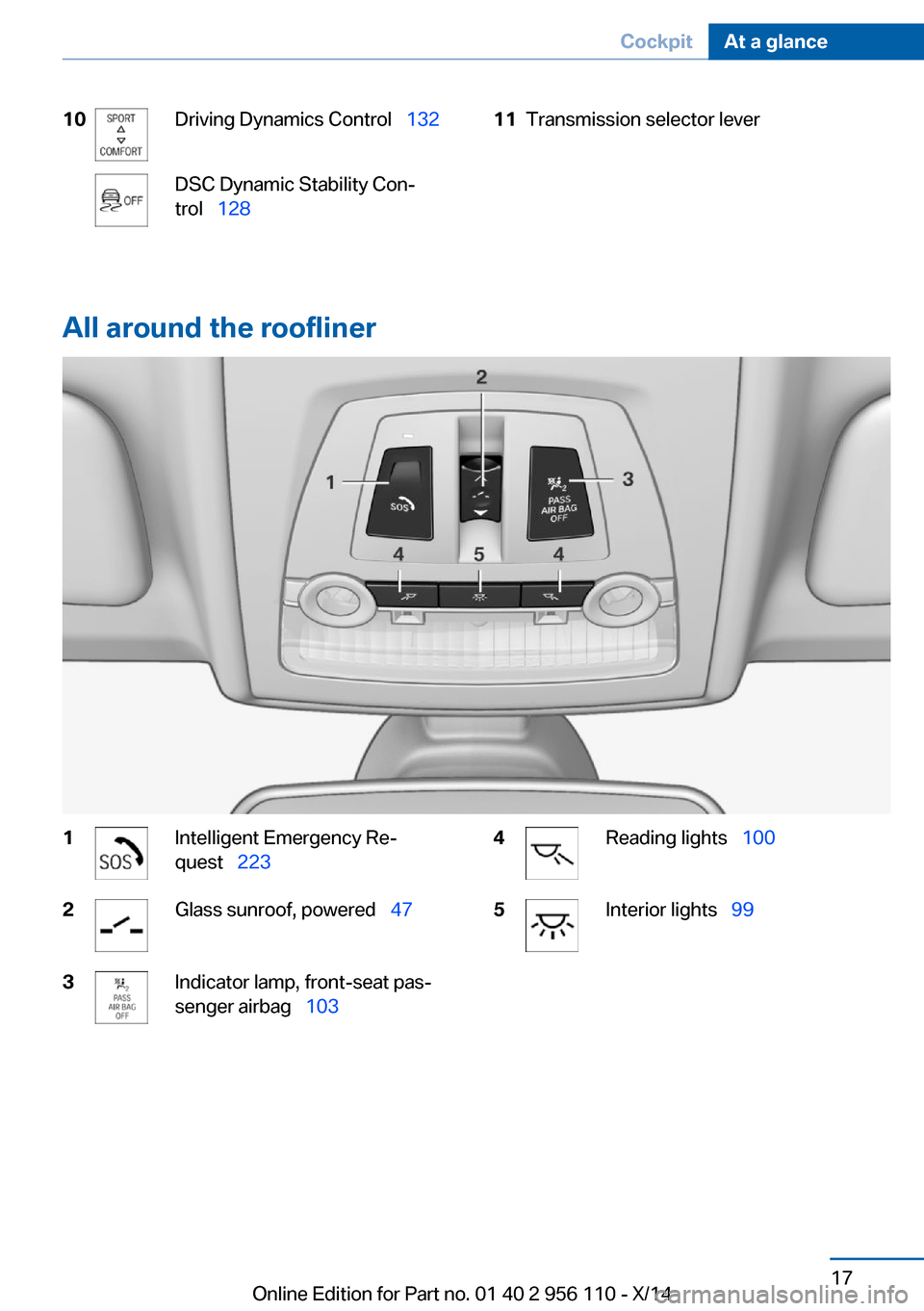
10Driving Dynamics Control‚ÄÇ‚ÄÖ132DSC Dynamic Stability Con‚Äê
trol‚ÄÇ‚ÄÖ 12811Transmission selector lever
All around the roofliner
1Intelligent Emergency Re‚Äê
quest‚ÄÇ‚ÄÖ 2232Glass sunroof, powered‚ÄÇ‚ÄÖ 473Indicator lamp, front-seat pas‚Äê
senger airbag‚ÄÇ‚ÄÖ 1034Reading lights‚ÄÇ‚ÄÖ 1005Interior lights‚ÄÇ‚ÄÖ99Seite 17CockpitAt a glance17
Online Edition for Part no. 01 40 2 956 110 - X/14
Page 41 of 253

Existing settings and contacts are overwritten
with the imported profile.1."Settings"2."Profiles"3."Import profile"4.BMW Online: "BMW Online"
USB interface: "USB device"
Using the guest profile
The guest profile is for individual settings that
are saved in none of the three personal pro‚Äê
files.
This can be useful for drivers who are using
the vehicle temporarily and do not have their
own profile.
1."Settings"2."Profiles"3."Guest"
The guest profile cannot be renamed. It is not
assigned to the current remote control.
Display profile list during start
The profile list can be displayed during each
start to select the desired profile.
1."Settings"2."Profiles"3."Options"4."Display user list at startup"
Using the remote control
Note Take the remote control with youPeople or animals left unattended in a
parked vehicle can lock the doors from the in‚Äê
side. Always take the remote control with you
when leaving the vehicle so that the vehicle
can then be opened from the outside.‚óÄ
Unlocking
Press button on the remote control.‚ñ∑All doors and the trunk lid are unlocked.‚ñ∑Interior lamps and courtesy lamps are acti‚Äê
vated. This function is not available, if the
interior lamps were switched off manually.‚ñ∑The welcome lamps are switched on, if this
function was activated.‚ñ∑Exterior mirrors folded through convenient
closing are folded open.
You can set how the vehicle is to be unlocked.
For Settings, refer to page 42.
Anti-theft protection is switched off.
The alarm system, refer to page 43, is dis‚Äê
armed.
Convenient opening Press and hold this button on the re‚Äêmote control after unlocking.
The windows are opened, the glass sunroof is
tilted and the sliding visor moves back, as long
as the button on the remote control is pressed.
Locking Locking from the outside
Do not lock the vehicle from the outside
with people inside the car, as the vehicle can‚Äê
not be unlocked from inside without special knowledge.‚óÄ
Press button on the remote control.
All doors and the trunk lid are locked.
Anti-theft protection is switched on. It pre‚Äê
vents the doors from being unlocked using the
lock buttons or the door openers.
The alarm system, refer to page 43, is armed.
Seite 37Opening and closingControls37
Online Edition for Part no. 01 40 2 956 110 - X/14
Page 46 of 253

Locking
Touch the surface on the handle of a vehicle
door, arrow, with your finger for approx. 1 sec‚Äê
ond without grasping the door handle.
This corresponds with pressing the button on
the remote control.
To save battery power, ensure that the ignition
and all electronic systems and/or power con‚Äê
sumers are turned off before locking the vehi‚Äê
cle.
Convenient closing Monitor closing
Monitor closing to ensure that no one
becomes trapped.‚óÄ
Touch the surface on the handle of a vehicle
door, arrow, with your finger and hold it there
without grasping the door handle.
This corresponds to pressing and holding
the remote control button.
In addition to locking, the windows and the
glass sunroof close and the exterior mirrors
fold in.
Separately unlocking the trunk lid
Press button on the exterior of the trunk lid.
This corresponds to pressing
the re‚Äê
mote control button.
The situation of the doors does not change.
Do not place the remote control in the
cargo area
Take the remote control with you and do not
leave it in the cargo area; otherwise, the re‚Äê
mote control is locked inside the vehicle when
the trunk lid is closed.‚óÄ
Malfunction
Remote control detection by the vehicle can
among others be malfunctioning under the fol‚Äê
lowing circumstances:
‚ñ∑Interference of the radio connection from
transmission towers or other equipment
with high transmit power.‚ñ∑Shielding of the remote control due to
metal objects.‚ñ∑Interference of the radio connection from
mobile phones or other electronic devices
in direct proximity.
Do not transport the remote control together
with metal objects or electronic devices.
In the case of a malfunction, unlock and lock
the vehicle using the buttons of the remote
control or using the integrated key, refer to
page 39.
Adjusting
Unlocking The settings are saved in the active profile, re‚Äê
fer to page 35.
Doors
1."Settings"2."Doors/key"Seite 42ControlsOpening and closing42
Online Edition for Part no. 01 40 2 956 110 - X/14
Page 48 of 253
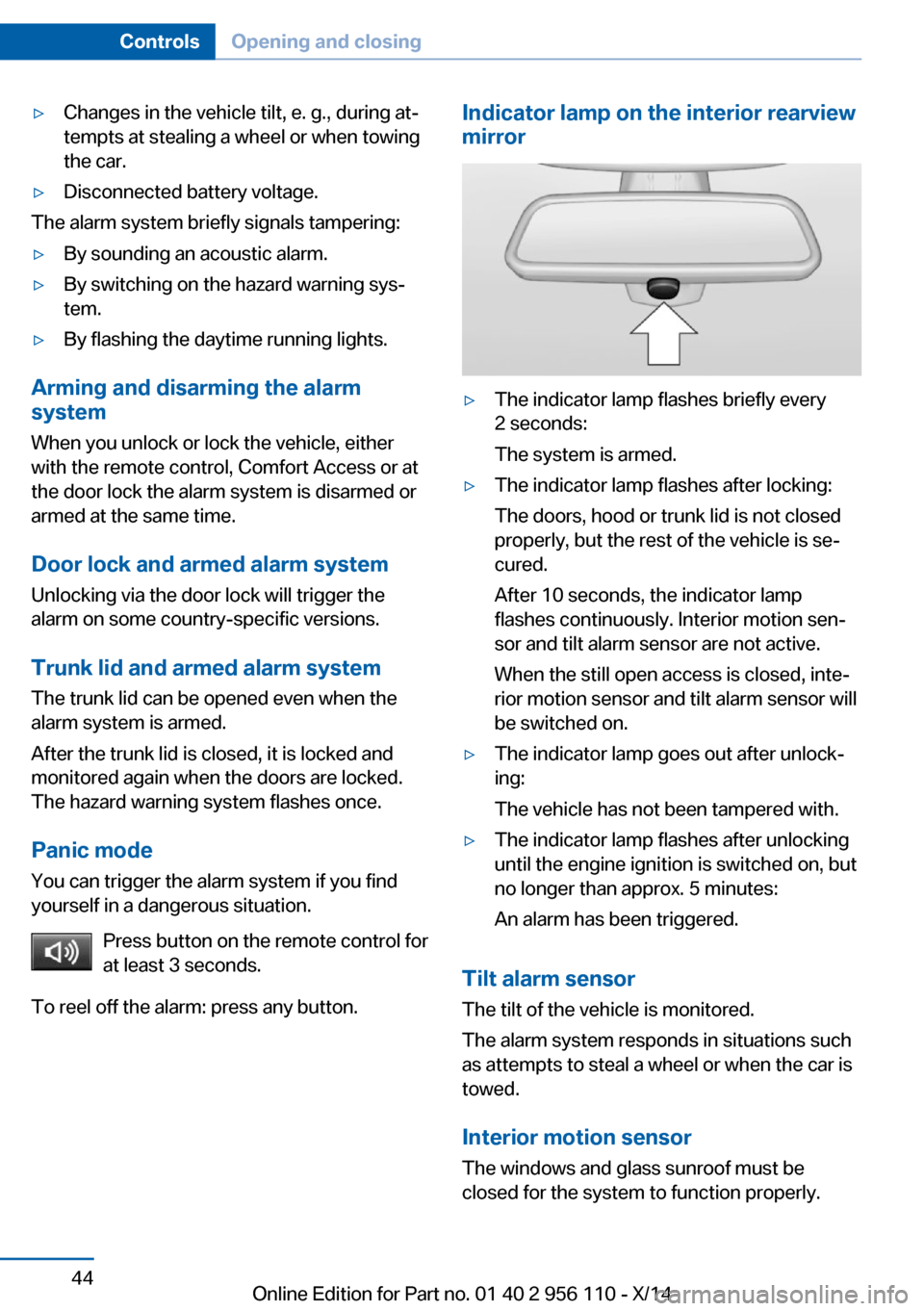
‚ñ∑Changes in the vehicle tilt, e. g., during at‚Äê
tempts at stealing a wheel or when towing
the car.‚ñ∑Disconnected battery voltage.
The alarm system briefly signals tampering:
‚ñ∑By sounding an acoustic alarm.‚ñ∑By switching on the hazard warning sys‚Äê
tem.‚ñ∑By flashing the daytime running lights.
Arming and disarming the alarm
system
When you unlock or lock the vehicle, either
with the remote control, Comfort Access or at
the door lock the alarm system is disarmed or
armed at the same time.
Door lock and armed alarm systemUnlocking via the door lock will trigger the
alarm on some country-specific versions.
Trunk lid and armed alarm system The trunk lid can be opened even when the
alarm system is armed.
After the trunk lid is closed, it is locked and
monitored again when the doors are locked.
The hazard warning system flashes once.
Panic mode
You can trigger the alarm system if you find
yourself in a dangerous situation.
Press button on the remote control for
at least 3 seconds.
To reel off the alarm: press any button.
Indicator lamp on the interior rearview
mirror‚ñ∑The indicator lamp flashes briefly every
2 seconds:
The system is armed.‚ñ∑The indicator lamp flashes after locking:
The doors, hood or trunk lid is not closed
properly, but the rest of the vehicle is se‚Äê
cured.
After 10 seconds, the indicator lamp
flashes continuously. Interior motion sen‚Äê
sor and tilt alarm sensor are not active.
When the still open access is closed, inte‚Äê
rior motion sensor and tilt alarm sensor will
be switched on.‚ñ∑The indicator lamp goes out after unlock‚Äê
ing:
The vehicle has not been tampered with.‚ñ∑The indicator lamp flashes after unlocking
until the engine ignition is switched on, but
no longer than approx. 5 minutes:
An alarm has been triggered.
Tilt alarm sensor The tilt of the vehicle is monitored.
The alarm system responds in situations such
as attempts to steal a wheel or when the car is
towed.
Interior motion sensor The windows and glass sunroof must be
closed for the system to function properly.
Seite 44ControlsOpening and closing44
Online Edition for Part no. 01 40 2 956 110 - X/14
Page 51 of 253
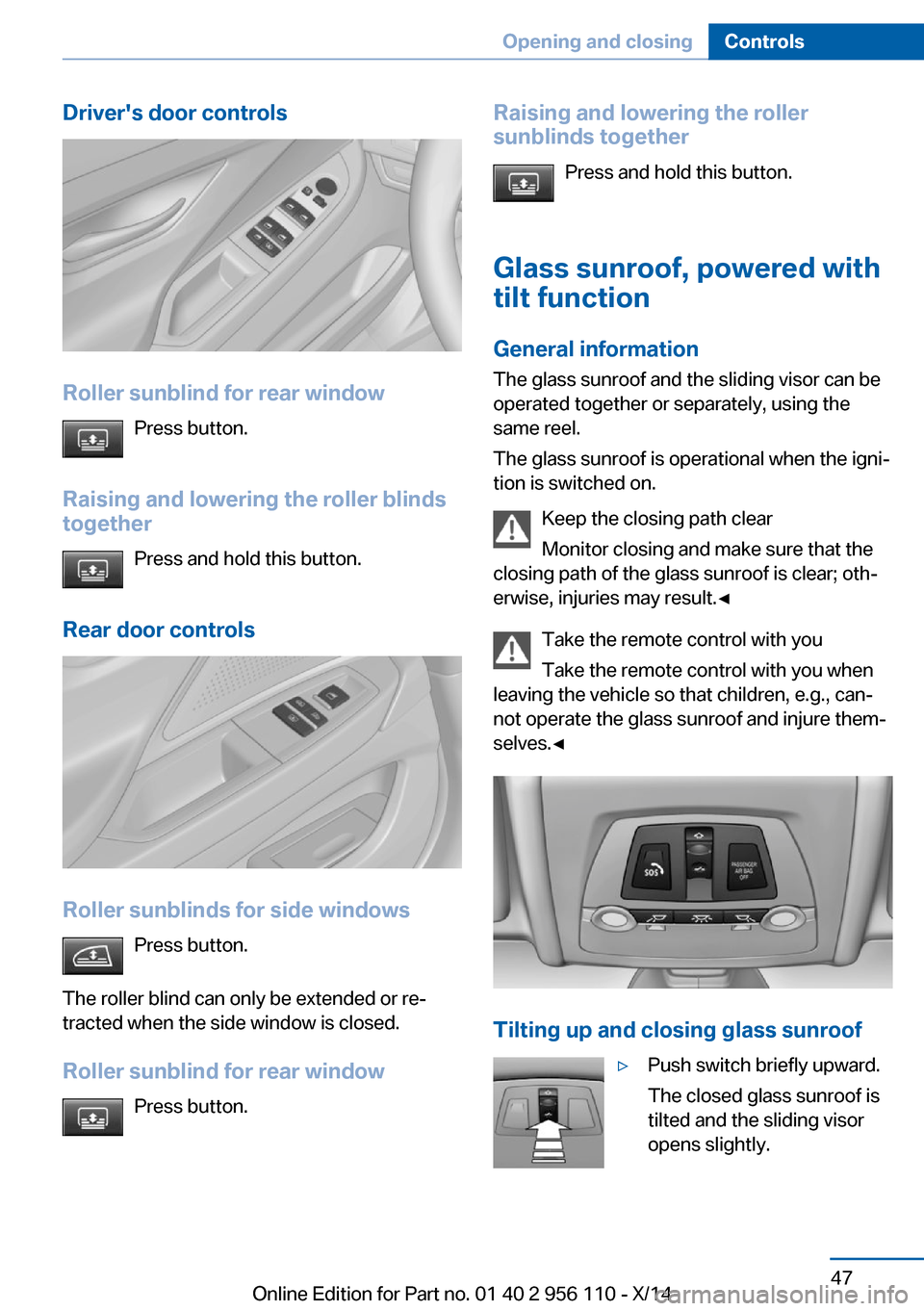
Driver's door controls
Roller sunblind for rear windowPress button.
Raising and lowering the roller blinds
together
Press and hold this button.
Rear door controls
Roller sunblinds for side windows Press button.
The roller blind can only be extended or re‚Äê
tracted when the side window is closed.
Roller sunblind for rear window Press button.
Raising and lowering the roller
sunblinds together
Press and hold this button.
Glass sunroof, powered with tilt function
General information The glass sunroof and the sliding visor can be
operated together or separately, using the
same reel.
The glass sunroof is operational when the igni‚Äê
tion is switched on.
Keep the closing path clear
Monitor closing and make sure that the
closing path of the glass sunroof is clear; oth‚Äê
erwise, injuries may result.‚óÄ
Take the remote control with you
Take the remote control with you when
leaving the vehicle so that children, e.g., can‚Äê
not operate the glass sunroof and injure them‚Äê
selves.‚óÄ
Tilting up and closing glass sunroof
‚ñ∑Push switch briefly upward.
The closed glass sunroof is
tilted and the sliding visor
opens slightly.Seite 47Opening and closingControls47
Online Edition for Part no. 01 40 2 956 110 - X/14
Page 52 of 253

‚ñ∑Briefly press out the reel
twice in succession toward
the rear past the resistance
point.
Closed glass sunroof is tilted
and the sliding visor moves
all the way back.‚ñ∑To close the reel, press upward briefly or
twice forward past the resistance point.
Additional options:
‚ñ∑Convenient opening, refer to page 37, via
the remote control.‚ñ∑Closing by means of Comfort Access, refer
to page 41.
Opening/closing the sliding visor
‚ñ∑Press the reel in the desired
direction to the resistance
point and hold it there.
The sliding visor moves, as
long as the reel is held
down.‚ñ∑Press the reel in the desired direction past
the resistance point.
The sliding visor moves automatically.
Pressing the reel upward stops the motion.
Pinch protection system If the closing force exceeds a specific value as
a glass sunroof closes, the closing action is in‚Äê
terrupted.
The glass sunroof is tilted again.
Danger of jamming even with pinch pro‚Äê
tection
Despite the pinch protection system, check
that the glass sunroof's closing path is clear;
otherwise, the closing action may not be inter‚Äê
rupted in certain extreme situations, such as
when thin objects are present.‚óÄ
Closing without the pinch protection
system
If there is an external danger or if, e. g., icing
prevents automatic closing, push the reel for‚Äê
ward past the resistance point and hold it.
The glass sunroof closes without jam protec‚Äê
tion. Make sure that the closing area is clear.
Initializing after a power failure
After a power failure during the opening or
closing process, the glass sunroof can only be
operated to a limited extent.
Initializing the system The system can be initialized when the vehicle
is stationary and the engine is running.
During the initialization, the glass sunroof
closes without jam protection.
Keep the closing path clear
Monitor closing and make sure that the
closing path of the glass sunroof is clear; oth‚Äê
erwise, injuries may result.‚óÄ
Press the reel up and hold it until
the initialization is complete:‚ñ∑Initialization begins within
15 seconds and is com‚Äê
pleted when the glass sun‚Äê
roof and sliding visor are
completely closed.‚ñ∑The glass sunroof closes without jam pro‚Äê
tection.Seite 48ControlsOpening and closing48
Online Edition for Part no. 01 40 2 956 110 - X/14
Page 130 of 253
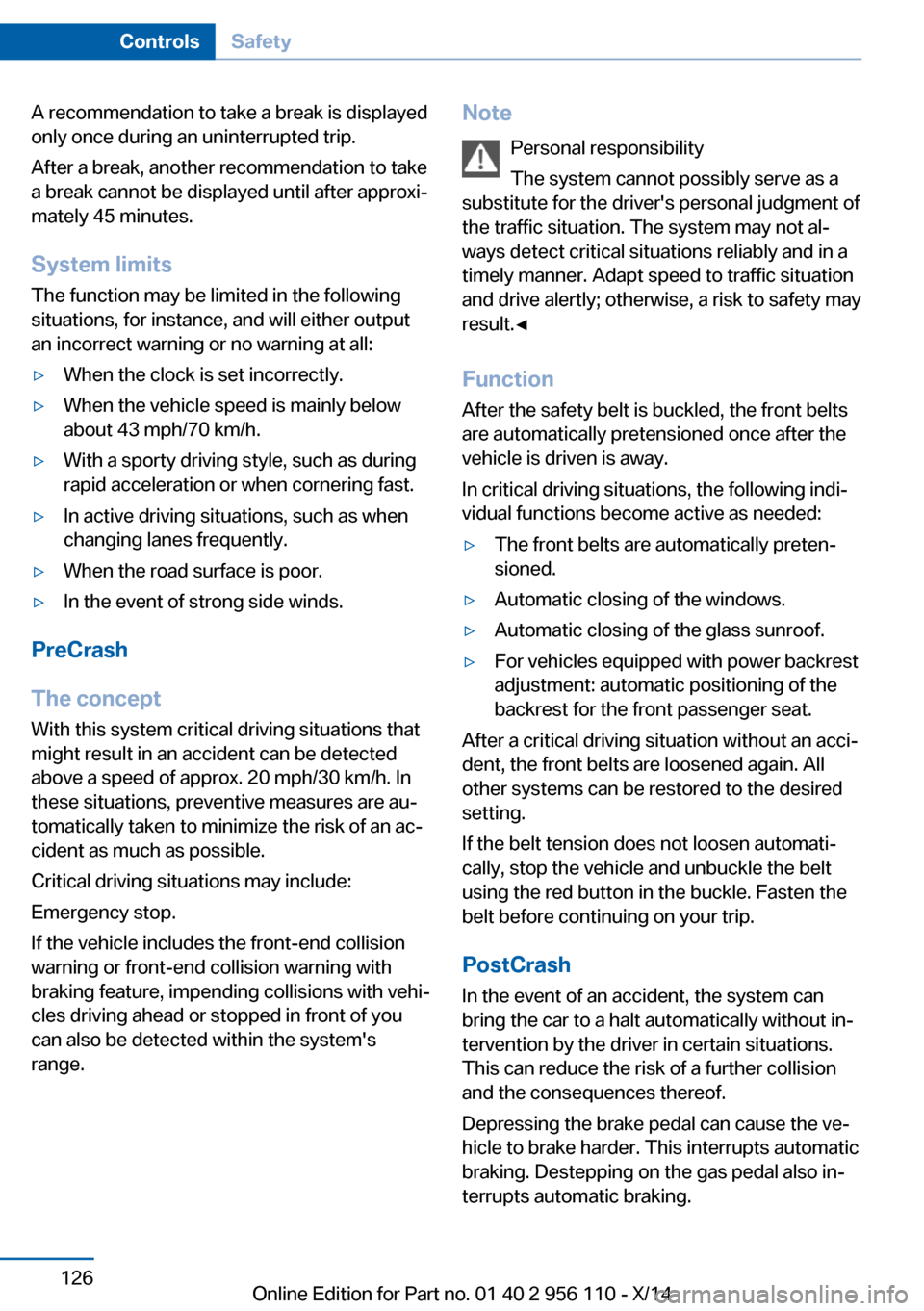
A recommendation to take a break is displayed
only once during an uninterrupted trip.
After a break, another recommendation to take
a break cannot be displayed until after approxi‚Äê
mately 45 minutes.
System limits
The function may be limited in the following
situations, for instance, and will either output
an incorrect warning or no warning at all:‚ñ∑When the clock is set incorrectly.‚ñ∑When the vehicle speed is mainly below
about 43 mph/70 km/h.‚ñ∑With a sporty driving style, such as during
rapid acceleration or when cornering fast.‚ñ∑In active driving situations, such as when
changing lanes frequently.‚ñ∑When the road surface is poor.‚ñ∑In the event of strong side winds.
PreCrash
The concept With this system critical driving situations that
might result in an accident can be detected
above a speed of approx. 20 mph/30 km/h. In these situations, preventive measures are au‚Äê
tomatically taken to minimize the risk of an ac‚Äê
cident as much as possible.
Critical driving situations may include:
Emergency stop.
If the vehicle includes the front-end collision
warning or front-end collision warning with
braking feature, impending collisions with vehi‚Äê
cles driving ahead or stopped in front of you
can also be detected within the system's
range.
Note
Personal responsibility
The system cannot possibly serve as a
substitute for the driver's personal judgment of
the traffic situation. The system may not al‚Äê
ways detect critical situations reliably and in a
timely manner. Adapt speed to traffic situation
and drive alertly; otherwise, a risk to safety may
result.‚óÄ
Function
After the safety belt is buckled, the front belts
are automatically pretensioned once after the
vehicle is driven is away.
In critical driving situations, the following indi‚Äê
vidual functions become active as needed:‚ñ∑The front belts are automatically preten‚Äê
sioned.‚ñ∑Automatic closing of the windows.‚ñ∑Automatic closing of the glass sunroof.‚ñ∑For vehicles equipped with power backrest
adjustment: automatic positioning of the
backrest for the front passenger seat.
After a critical driving situation without an acci‚Äê
dent, the front belts are loosened again. All
other systems can be restored to the desired
setting.
If the belt tension does not loosen automati‚Äê
cally, stop the vehicle and unbuckle the belt
using the red button in the buckle. Fasten the
belt before continuing on your trip.
PostCrash
In the event of an accident, the system can
bring the car to a halt automatically without in‚Äê
tervention by the driver in certain situations.
This can reduce the risk of a further collision
and the consequences thereof.
Depressing the brake pedal can cause the ve‚Äê
hicle to brake harder. This interrupts automatic
braking. Destepping on the gas pedal also in‚Äê terrupts automatic braking.
Seite 126ControlsSafety126
Online Edition for Part no. 01 40 2 956 110 - X/14
Page 182 of 253

Things to remember when drivingVehicle features and options
This chapter describes all standard, country-
specific and optional features offered with the
series. It also describes features that are not
necessarily available in your car, e. g., due to
the selected options or country versions. This
also applies to safety-related functions and
systems.
Breaking-in period
General information Moving parts need time to adjust to one an‚Äê
other (break-in time).
The following instructions will help accomplish
a long vehicle life and good efficiency.
During break-in, do not use the Launch Con‚Äê
trol, refer to page 75.
Engine, transmission, and axle drive Always obey the official speed limit.
Up to 1,200 miles/2,000 km
Do not exceed the maximum engine and road
speed:‚ñ∑For gasoline engine 4,500 rpm and
100 mph/160 km/h.
Avoid full load or kickdown under all circum‚Äê
stances.
From 1,200 miles/2,000 km The engine and vehicle speed can gradually be
increased.
Tires
Tire traction is not optimal due to manufactur‚Äê
ing circumstances when tires are brand-new;
they achieve their full traction potential after a
break-in time.
Drive conservatively for the first
200 miles/300 km.
Brake system
Brakes require an initial break-in period of ap‚Äê
prox. 300 miles/500 km to achieve optimal per‚Äê
formance between brake discs and brake
pads. Drive moderately during this break-in pe‚Äê
riod.
Following part replacement
The same break-in procedures should be ob‚Äê
served if any of the components above-men‚Äê
tioned have to be renewed in the course of the
vehicle's operating life.
General driving notes
Closing the trunk lid Drive with the trunk lid closed
Only drive with the tailgate closed; other‚Äê
wise, in the event of an accident or braking and
evasive maneuvers, passengers and other traf‚Äê
fic may be injured, and the vehicle may be
damaged. In addition, exhaust fumes may en‚Äê
ter the vehicle interior.‚óÄ
If driving with the tailgate open cannot be
avoided:‚ñ∑Close all windows and the glass sunroof.‚ñ∑Greatly increase the air flow from the vents.‚ñ∑Drive moderately.
Hot exhaust system
Hot exhaust system
High temperatures are generated in the
exhaust system.
Seite 178Driving tipsThings to remember when driving178
Online Edition for Part no. 01 40 2 956 110 - X/14
Page 187 of 253
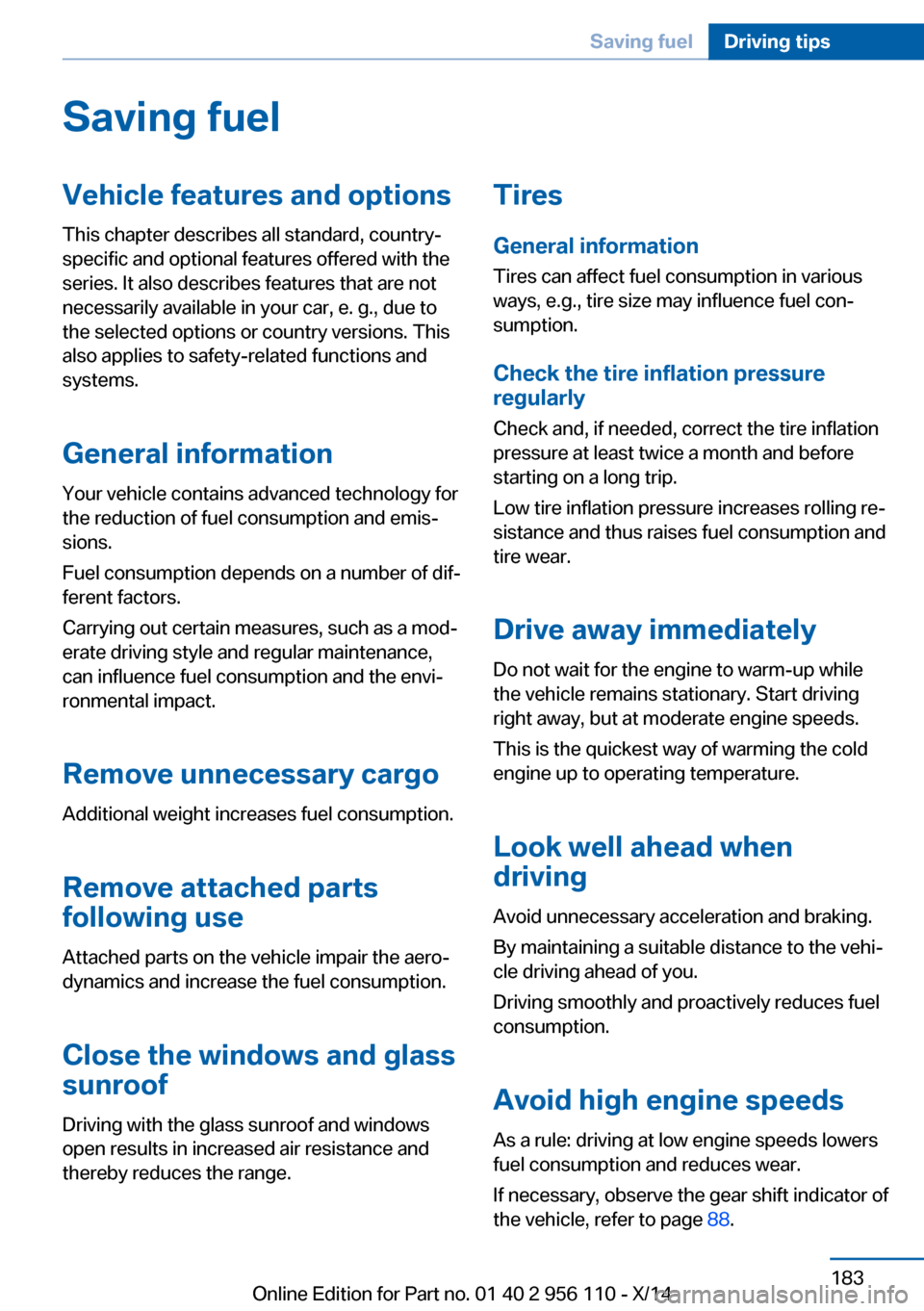
Saving fuelVehicle features and optionsThis chapter describes all standard, country-
specific and optional features offered with the
series. It also describes features that are not
necessarily available in your car, e. g., due to
the selected options or country versions. This
also applies to safety-related functions and
systems.
General information
Your vehicle contains advanced technology for
the reduction of fuel consumption and emis‚Äê
sions.
Fuel consumption depends on a number of dif‚Äê
ferent factors.
Carrying out certain measures, such as a mod‚Äê
erate driving style and regular maintenance,
can influence fuel consumption and the envi‚Äê
ronmental impact.
Remove unnecessary cargoAdditional weight increases fuel consumption.
Remove attached parts
following use
Attached parts on the vehicle impair the aero‚Äê
dynamics and increase the fuel consumption.
Close the windows and glasssunroof
Driving with the glass sunroof and windows
open results in increased air resistance and
thereby reduces the range.Tires
General information
Tires can affect fuel consumption in various
ways, e.g., tire size may influence fuel con‚Äê
sumption.
Check the tire inflation pressure
regularly
Check and, if needed, correct the tire inflation
pressure at least twice a month and before
starting on a long trip.
Low tire inflation pressure increases rolling re‚Äê
sistance and thus raises fuel consumption and
tire wear.
Drive away immediately
Do not wait for the engine to warm-up while
the vehicle remains stationary. Start driving
right away, but at moderate engine speeds.
This is the quickest way of warming the cold
engine up to operating temperature.
Look well ahead when
driving
Avoid unnecessary acceleration and braking.
By maintaining a suitable distance to the vehi‚Äê
cle driving ahead of you.
Driving smoothly and proactively reduces fuel
consumption.
Avoid high engine speeds
As a rule: driving at low engine speeds lowers
fuel consumption and reduces wear.
If necessary, observe the gear shift indicator of
the vehicle, refer to page 88.Seite 183Saving fuelDriving tips183
Online Edition for Part no. 01 40 2 956 110 - X/14
Page 225 of 253
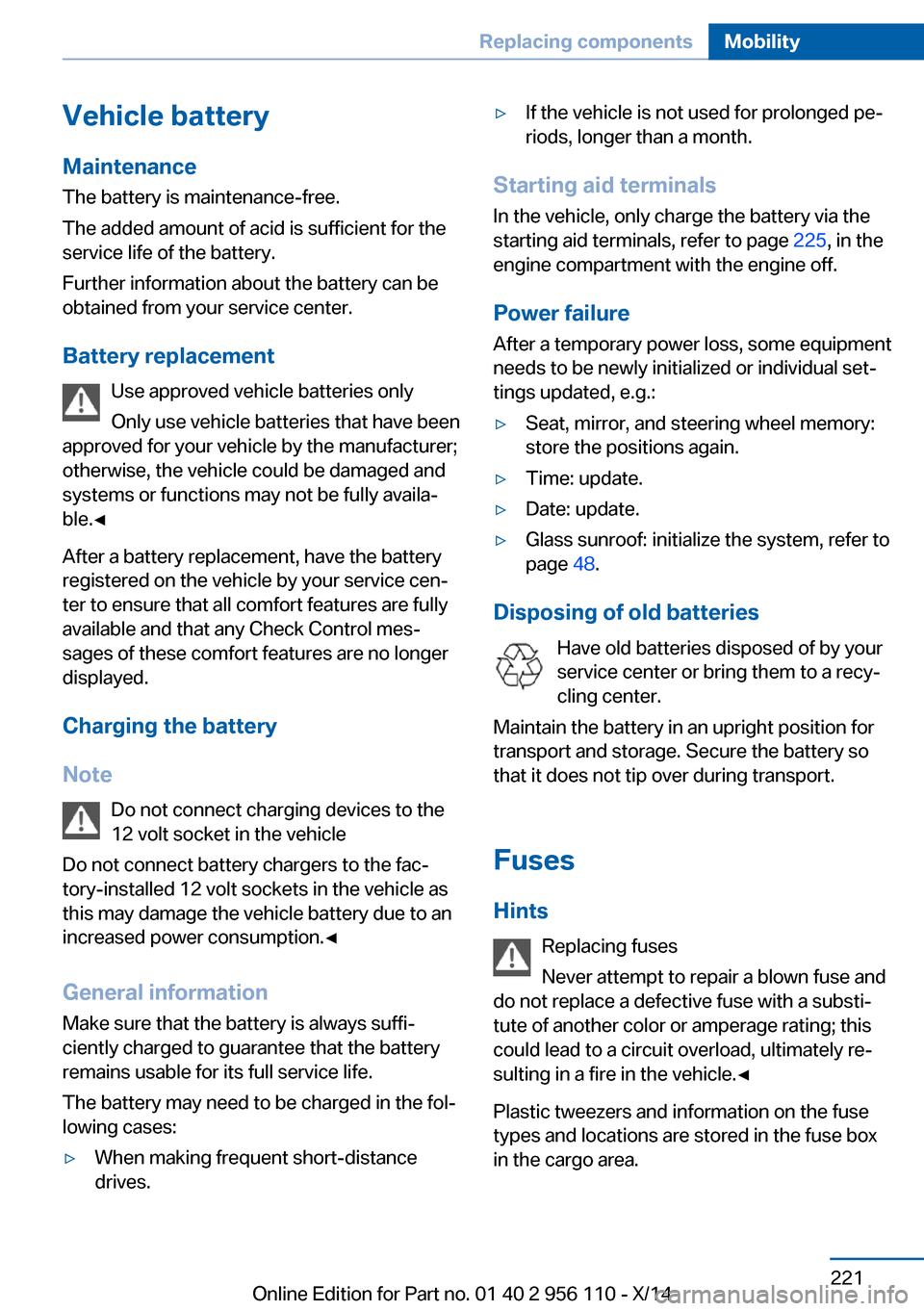
Vehicle batteryMaintenance
The battery is maintenance-free.
The added amount of acid is sufficient for the
service life of the battery.
Further information about the battery can be
obtained from your service center.
Battery replacement Use approved vehicle batteries only
Only use vehicle batteries that have been
approved for your vehicle by the manufacturer;
otherwise, the vehicle could be damaged and
systems or functions may not be fully availa‚Äê
ble.‚óÄ
After a battery replacement, have the battery
registered on the vehicle by your service cen‚Äê
ter to ensure that all comfort features are fully
available and that any Check Control mes‚Äê
sages of these comfort features are no longer
displayed.
Charging the battery
Note Do not connect charging devices to the12 volt socket in the vehicle
Do not connect battery chargers to the fac‚Äê
tory-installed 12 volt sockets in the vehicle as
this may damage the vehicle battery due to an
increased power consumption.‚óÄ
General information Make sure that the battery is always suffi‚Äê
ciently charged to guarantee that the battery
remains usable for its full service life.
The battery may need to be charged in the fol‚Äê
lowing cases:‚ñ∑When making frequent short-distance
drives.‚ñ∑If the vehicle is not used for prolonged pe‚Äê
riods, longer than a month.
Starting aid terminals
In the vehicle, only charge the battery via the
starting aid terminals, refer to page 225, in the
engine compartment with the engine off.
Power failure After a temporary power loss, some equipment
needs to be newly initialized or individual set‚Äê
tings updated, e.g.:
‚ñ∑Seat, mirror, and steering wheel memory:
store the positions again.‚ñ∑Time: update.‚ñ∑Date: update.‚ñ∑Glass sunroof: initialize the system, refer to
page 48.
Disposing of old batteries
Have old batteries disposed of by your
service center or bring them to a recy‚Äê
cling center.
Maintain the battery in an upright position for
transport and storage. Secure the battery so
that it does not tip over during transport.
Fuses Hints Replacing fuses
Never attempt to repair a blown fuse and
do not replace a defective fuse with a substi‚Äê
tute of another color or amperage rating; this
could lead to a circuit overload, ultimately re‚Äê
sulting in a fire in the vehicle.‚óÄ
Plastic tweezers and information on the fuse
types and locations are stored in the fuse box
in the cargo area.
Seite 221Replacing componentsMobility221
Online Edition for Part no. 01 40 2 956 110 - X/14